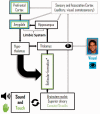Neural Mechanisms of Qigong Sensory Training Massage for Children With Autism Spectrum Disorder: A Feasibility Study
- PMID: 29662721
- PMCID: PMC5894902
- DOI: 10.1177/2164956118769006
Neural Mechanisms of Qigong Sensory Training Massage for Children With Autism Spectrum Disorder: A Feasibility Study
Abstract
Objectives: Despite the enormous prevalence of autism spectrum disorder (ASD), its global impact has yet to be realized. Millions of families worldwide need effective treatments to help them get through everyday challenges like eating, sleeping, digestion, and social interaction. Qigong Sensory Training (QST) is a nonverbal, parent-delivered intervention recently shown to be effective at reducing these everyday challenges in children with ASD. This study tested the feasibility of a protocol for investigating QST's neural mechanism.
Methods: During a single visit, 20 children, 4- to 7-year-old, with ASD viewed images of emotional faces before and after receiving QST or watching a video (controls). Heart rate variability was recorded throughout the visit, and power in the high frequency band (0.15-0.4 Hz) was calculated to estimate parasympathetic tone in 5-s nonoverlapping windows. Cerebral oximetry of prefrontal cortex was recorded during rest and while viewing emotional faces.
Results: 95% completion rate and 7.6% missing data met a priori standards confirming protocol feasibility for future studies. Preliminary data suggest: (1) during the intervention, parasympathetic tone increased more in children receiving massage (M = 2.9, SD = 0.3) versus controls (M = 2.5, SD = 0.5); (2) while viewing emotional faces post-intervention, parasympathetic tone was more affected (reduced) in the massage group (p = 0.036); and (3) prefrontal cortex response to emotional faces was greater after massage compared to controls. These results did not reach statistical significance in this small study powered to test feasibility.
Discussion/conclusion: This study demonstrates solid protocol feasibility. If replicated in a larger sample, these findings would provide important clues to the neural mechanism of action underlying QST's efficacy for improving sensory, social, and communication difficulties in children with autism.
Keywords: Complementary and Alternative Medicine; Qigong Sensory Training; autism; autonomic nervous system; cerebral oximetry; heart rate variability; massage; nonclassical auditory pathway; parasympathetic tone; vagal tone.
Figures



References
-
- Zablotsky B, Black LI, Maenner MJ, Schieve LA, Blumberg SJ. Estimated prevalence of autism and other developmental disabilities following questionnaire changes in the 2014 National Health Interview Survey. Natl Health Stat Report. 2015;87:1–20. - PubMed
-
- World Health Organization. Autism Spectrum Disorder Fact Sheet. http://www.who.int/mediacentre/factsheets/autism-spectrum-disorders/en/. Updated April 2017. Accessed September 2017.
-
- National Autism Association. Autism Fact Sheet. http://nationalautismassociation.org/resources/autism-fact-sheet/. Updated 2018. Accessed February 6, 2018.
-
- Benevides TW, Lane SJ. A review of cardiac autonomic measures: considerations for examination of physiological response in children with autism spectrum disorder. J Autism Dev Disord. 2015;45(2): 560–575. - PubMed
Grants and funding
LinkOut - more resources
Full Text Sources
Other Literature Sources
Miscellaneous

